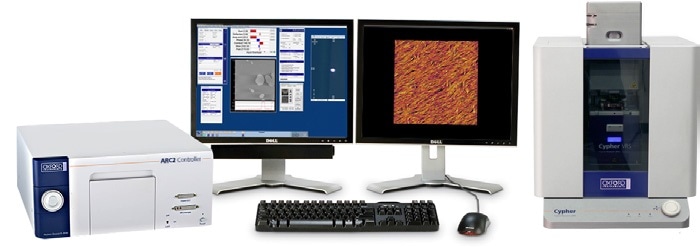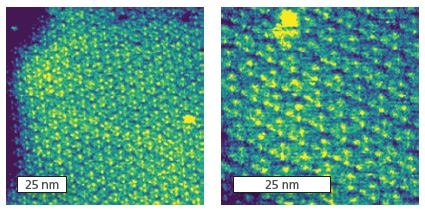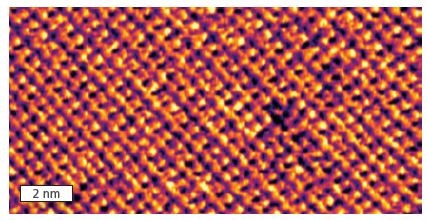The Cypher VRS AFM is the first and only full-featured video-rate AFM. Researchers can finally measure nanoscale dynamic processes at video-rate speeds with all of the versatility, resolution and ease of use that are hallmarks of an Asylum Research Cypher™ AFM.
- Excellent ease of use — even at 10 frames per second (fps)
- High resolution video-rate imaging — at up to 625 lines per second
- Complete range of modes and accessories — all the capabilities of Cypher ES at normal scan speeds
Biochemical Reactions at Video-Rate Speeds

DNA cleaved by DNase1 enzyme
Lambda digest DNA was bound to a mica substrate with MgCl2 buffer, and DNase was introduced. In the first image (left), several DNA strands are observed. In the second image (center), note the DNase enzyme bound to one of the overlapping strands (circle). In the third and last image (right), this strand has cleaved at the binding point. Imaged at a line rate of 625 Hz at 320×64 pixels for a frame rate of 8.7 fps with an Olympus AC10 probe.
Many scientists, like myself, have been inspired by early video-rate AFM results, but have been reluctant to invest in a single purpose AFM with a constrained sample configuration and limited range of scan sizes. What impresses me about the Cypher VRS is that it can achieve high speed without these constraints while maintaining the microscope’s versatility and ease of use, whether for imaging or force spectroscopy.
Jim De Yoreo, Chief Scientist, Pacific Northwest National Laboratory
Remarkably Easy to Use, Even at Video-Rate Speeds
Cypher VRS Lets Users Concentrate on their Research Instead of their AFM
Cypher VRS is video-rate AFM made simple
- Scanner is very robust and completely sealed against liquid spills for complete reliability.
- Probes are easily loaded and clamped in place, just like a regular Cypher probe holder.
- Probe holder is available with or without perfusion ports for liquid exchange.
- Effortless sample mounting with no extreme limits on the maximum sample size.
- Motorized laser and detector alignment makes quick work of instrument setup.
- All imaging controls are accessed through a simple software user interface.
- Powerful built-in movie maker generates spectacular publication-quality results.

Assembly of collagen fibrils on mica
The movie begins with imaging bare mica in tapping mode in buffer at a line rate of 400 Hz with 512×256 pixels for a frame rate of 1.5 fps. A dilute solution of collagen molecules is added, and the self-assembly of ordered fibrils begins. The still frames above were captured at the times shown. The full movie contains many intermediate frames that show the process with much greater temporal detail. Sample courtesy of J. Tao and J. De Yoreo, Pacific Northwest National Laboratory.
blueDrive™ Makes Video-Rate AFM Simple and Stable on the Cypher VRS
blueDrive employs light to drive the cantilever oscillation. Unlike a tapping piezo, it directly acts on the cantilever and does not excite other system resonances. The result is clean tunes that make it easy to use small, fast cantilevers. blueDrive keeps the drive response constant even as liquids are perfused or exchanged, providing stable imaging without any need to alter the setpoint.

Tune of a small, fast AC40 cantilever driven with blueDrive closely matches the theoretical response, while the piezo-driven response has multiple peaks.
Completely Integrated Electronics and Software Deliver Extraordinary AFM Performance with a Stunningly Simple User Experience

The First and Only Full-Featured Video-Rate AFM
Cypher VRS is Not a “One-Trick Pony,” it is a Workhorse for the Whole Lab
More Than Just a Video-Rate AFM — Also Supports All Cypher ES Accessories and Modes
Buying an AFM that can only be used on specific projects can be difficult to justify. Hence, the Cypher VRS was built with unparalleled versatility. It can be used by a whole lab and completely satisfies the diverse requirements of large interdisciplinary research groups.
Capabilities at Video-Rate Scan Speeds
- Video-rate imaging is currently available in tapping mode (including phase) and contact mode.
- Image under ambient conditions in air or liquids. (Cypher ES environmental control accessories cannot be used while imaging at video rates.)
- Work in a completely sealed sample chamber or use the optional perfusion probe holder.
Unlimited Capabilities at Normal Scan Speeds
- Includes all of the modes integrated on the Cypher ES with blueDrive (see below).
- Supports all of the optional modes available on the Cypher ES (see below).
- Compatible with all of the Cypher ES optional accessories (see below).
Already Have a Cypher AFM?
- Existing Cypher S and Cypher ES systems can be upgraded to the Cypher VRS (inquire for details).
- Most accessories and options can be shared between separate Cypher ES and VRS systems.
Included Operating Modes
AM-FM Viscoelastic Mapping Mode; Contact Resonance Viscoelastic Mapping Mode; Contact mode; Dual AC™; Dual AC Resonance Tracking (DART); DART PFM; Electrostatic force microscopy (EFM); Force curves; Force mapping mode (force volume); Force modulation; Frequency modulation; Kelvin probe force microscopy (KPFM); Lateral force mode (LFM); Loss tangent imaging; Magnetic force microscopy (MFM); Nanolithography and nanomanipulation; Phase imaging; Piezoresponse force microscopy (PFM); Switching spectroscopy PFM; Tapping mode (AC mode); Tapping mode with digital Q control; Vector PFM.
Optional Operating Modes
Conductive AFM (CAFM) with ORCA™ and Eclipse™ mode; Fast Force Mapping Mode; Current mapping with Fast Force Mapping; Electrochemical Strain Microscopy (ESM); High Voltage PFM; Nanoscale Time Dependent Dielectric Breakdown (nanoTDDB); Scanning Tunneling Microscopy (STM)
Optional Accessories
- Heating and cooling Maintain samples at temperatures between 0 °C and 100 °C in gas or liquid environments.
- Heating Heat samples at temperatures up to 250 °C. Completely sealed chamber can control the gas environment.
- Humidity sensing Completely sealed chamber with an integrated humidity sensor.
- Liquid perfusion probe holder Ports permit exchange or perfusion of liquid.
- Electrochemistry cell Sealed cell with integrated electrodes and potentiostat interface for electrochemical studies.
Speed that Goes Beyond Fast Scanning AFMs
Cypher VRS Sets a New Speed Benchmark with Superb Imaging Resolution
Cypher VRS is Faster - Much Faster - Than Current Generation “Fast Scanning” AFMs
- Capture images at high pixel density (512×512) in just over a second, or reduce scan lines to achieve video rates >10 fps
- Scan at up to 625 lines per second, about 300× faster than normal AFMs and at least 10× faster than current “fast scanning” AFMs
Powered by Asylum Research’s Unrivalled Technology Leadership
- State-of-the-art, piezo-driven XY flexure scanner integrates ultra-low-noise LVDT sensors for accurate scanning and offsets
- Modular high-speed Z scanner allows users to quickly switch between video-rate imaging and other modes and accessories without replacing the whole scanner
- Sine-wave scanning extends XY scanner performance without sacrificing accuracy
- Small-spot laser and blueDrive photothermal excitation enable use of the fastest, smallest, lowest-noise AFM probes
- Proprietary high-speed, high-voltage amplifier increases imaging bandwidth
- Same compact, rigid construction as other Cypher AFMs achieves noise levels at least 50% lower than any other AFM.
Cypher VRS Attains Higher Resolution than Ever Before at Video-Rate Speeds
- Maintains high-resolution even on soft and loosely bound biological samples
- Same fast, consistent high resolution imaging as the rest of the Cypher family
High Resolution

Bacteriorhodopsin protein membrane
Topography images taken in tapping mode in buffer at a line rate of 280 Hz with 512×256 pixels for a frame rate of 1 fps. Sample courtesy of Tom Perkins, JILA, Univ. of Colorado at Boulder.

Atomic defects in a calcite crystal
Topography image taken with tapping mode in water at a line rate of 100 Hz with 512×100 pixels for a frame rate of 1 fps.
Specifications
Video-Rate Scanning Performance
- Maximum line scan rate Up to 625 lines/s
- Maximum data pixel rate Up to 500,000 pixels/s
- Maximum frame rate Determined by the image pixel density selected by the user. The table below gives several examples
| |
320 points |
512 points |
1024 points |
| 40 lines |
13.6 |
8.5 |
4.2 |
| 64 lines |
8.7 |
5.4 |
2.7 |
| 128 lines |
4.5 |
2.8 |
1.4 |
| 256 lines |
2.3 |
1.5 |
0.7 |
- X and Y range 10 μm for line scan rates >40 Hz (closed-loop scanning)
- X and Y sensor noise <60 pm
- Z range >2 μm
- Sample mounting Samples are mounted to the sapphire end cap of the Z scanner using adhesive to maximize speed.
- DC height noise <15 pm (<5 pm typical in quiet lab)
- AC height noise <15 pm
- Supported modes Tapping (with phase) or contact mode
- Supported options Liquid perfusion probe holder
- Sample size Up to 15 mm diameter, though for highest speed performance smaller is better. All results shown here were for samples at least 3 mm in diameter.
Cantilever Deflection Sensing
- Four modules are available (purchased individually):
- Standard SLD Module: Superluminescent diode (SLD) source with nominal 10×30 μm spot size. Suggested for contact mode at normal speeds and force curves.
- Standard Laser Module: Modulated laser diode source with nominal 10×30 μm spot size. Recommended for most imaging applications at normal speeds.
- SLD Small Spot Module: Superluminescent diode source with nominal 3×9 μm spot size. Suggested for contact mode imaging at video rates.
- Laser Diode Small Spot Module: Modulated laser diode source with nominal 3×9 μm spot size. Required for tapping mode imaging at video rates.
- Wavelength 850 nm
- AC detector noise <25 fm⋅Hz -½ above 100 kHz
- DC detector noise <5 pm
- Detector bandwidth DC to 7 MHz
- Spot positioning and detector adjustment Completely motorized and software controlled
Normal-Rate Scanning Performance
- X&Y sensor noise <60 pm
- Z range >5 μm
- Z sensor noise <50 pm
- Sample size Up to 15 mm diameter
- Sample mounting Samples are mounted magnetically
- DC height noise <15 pm (<5 pm typical in quiet lab)
- AC height noise <15 pm
- Maximum data pixel rate Up to 50,000 pixels/s
- Maximum line scan rate Up to 156 lines/s
- X&Y range
- 30 μm for line scan rates ≤40 Hz
- 10 μm for line scan rates >40 Hz
(closed-loop scanning)
(Some modes and all environmental control accessories need a quick swap of the fast Z sample stage for a different stage.)
Top-View Bright-Field Optics
- Field of view 690×920 μm
- Resolution Diffraction limited (<1 μm), NA=0.45
- Illumination Intensity is software controlled. Manual controls for the aperture and field diaphragms.
blueDrive Photothermal Excitation
Included with all Cypher VRS systems.
- User-adjustable DC power Five ranges (0.1 mW, 0.3 mW, 1 mW, 3 mW and 10 mW), suitable for most standard and small cantilevers in both liquid and air environments.
- Drive frequency Up to 8 MHz
- Safety Certified FDA/IEC Class 1 (non-hazardous) 405 nm laser diode with fail-safe interlocks.
Instrument Isolation
- Vibration <10 pm coupling into deflection for 1 mm/s2 floor acceleration when using built-in passive isolation. No further isolation is necessary for typical laboratories.
- Acoustic Included enclosure provides 20 dB isolation.
Support
- Warranty Full two-year comprehensive warranty
- Support No-charge technical support and expert applications support for the lifespan of the AFM.